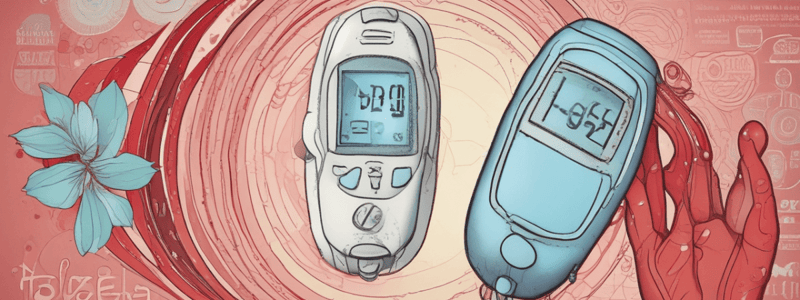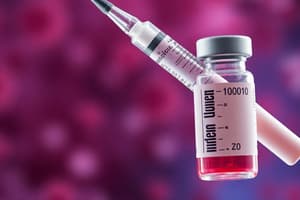Podcast
Questions and Answers
What is the primary cause of hypoglycemia?
What is the primary cause of hypoglycemia?
- Taking too little insulin
- Taking too much insulin, eating too little food, or a combination of both (correct)
- Not taking insulin at all
- Eating too much food and not taking enough insulin
What is the body's natural response to hypoglycemia?
What is the body's natural response to hypoglycemia?
- Reduced insulin production and increased glucon production (correct)
- Increased insulin production and decreased glucon production
- Increased epinephrine production
- Secretion of glucagon by the pancreas
What is the effect of a lack of glucagon response in hypoglycemia?
What is the effect of a lack of glucagon response in hypoglycemia?
- Decreased epinephrine production
- Glucose levels return to normal
- The body becomes more dependent on epinephrine to overcome hypoglycemia (correct)
- Increased insulin production
What is a common sign of hypoglycemia?
What is a common sign of hypoglycemia?
In which patients can hypoglycemia occur?
In which patients can hypoglycemia occur?
What can cause hypoglycemia?
What can cause hypoglycemia?
What is the result of the body's inability to excrete ketones and fatty acids in diabetic ketoacidosis?
What is the result of the body's inability to excrete ketones and fatty acids in diabetic ketoacidosis?
Which of the following is a common cause of diabetic ketoacidosis?
Which of the following is a common cause of diabetic ketoacidosis?
What is the typical range of blood glucose levels in non-fasting adults and children?
What is the typical range of blood glucose levels in non-fasting adults and children?
What is the primary treatment goal for patients with diabetic ketoacidosis?
What is the primary treatment goal for patients with diabetic ketoacidosis?
What is the characteristic breath odor associated with diabetic ketoacidosis?
What is the characteristic breath odor associated with diabetic ketoacidosis?
What is the term for the classic symptoms of uncontrolled diabetes, including frequent urination, excessive thirst, and excessive hunger?
What is the term for the classic symptoms of uncontrolled diabetes, including frequent urination, excessive thirst, and excessive hunger?
What is the typical treatment for patients with hypoglycemia who do not respond to dextrose?
What is the typical treatment for patients with hypoglycemia who do not respond to dextrose?
Which of the following is a characteristic of hyperosmolar hyperglycemic nonketotic syndrome?
Which of the following is a characteristic of hyperosmolar hyperglycemic nonketotic syndrome?
What is the primary goal of assessment for hypoglycemia and DKA?
What is the primary goal of assessment for hypoglycemia and DKA?
What is the threshold for initiating treatment for hypoglycemia?
What is the threshold for initiating treatment for hypoglycemia?
Flashcards are hidden until you start studying
Study Notes
- Hypoglycemia is a result of taking too much insulin, too little food, or a combination of both, leading to a hypoglycemic crisis known as insulin shock.
- Counterregulation is the body's natural defense mechanism to maintain blood glucose levels, with the first line of defense being reduced insulin production and increased glucon production, and the second line of defense being the secretion of catacolamines by the adrenal gland.
- A lack of glucagon response makes the body more dependent on epinephrine to overcome the effects of hypoglycemia, resulting in symptoms such as trembling, rapid heart rate, rapid shallow respirations, sweating, and a feeling of hunger.
- Common signs and symptoms of hypoglycemia include a blood glucose level below 70 mg/dL, hunger, agitation, irritability, altered mentation or confusion, weakness, dizziness or fainting, and cool clammy skin.
- Hypoglycemia can occur in patients with either type 1 or type 2 diabetes, and may even appear as intoxication due to slurred speech and lack of coordination.
- Do not discount the possibility of hypoglycemia in a comatose patient, even if they do not have a known diagnosis of diabetes, and do not let a known diagnosis of diabetes prevent consideration of other causes of coma.
- Hypoglycemia occurs when the blood glucose level remains elevated and corrective mechanisms have failed, which can be caused by excessive food intake, insufficient insulin dosages, infection, illness, injury, or emotional stress.
- A hypoglycemic crisis can lead to a diabetic coma, which is a state of unresponsiveness resulting from several problems, with common early signs including frequent and excessive thirst accompanied by frequent and excessive urination.
- Diabetic ketoacidosis (DKA) can occur when serum glucose levels rise above tolerable levels, causing several physiologic changes that can have detrimental long-term effects.
- Common causes of DKA include infection, injury, alcohol use, emotional distress, and illness such as stroke or myocardial infarction.
- The loss of water in large amounts causes the classic symptoms of uncontrolled diabetes, known as the three Ps: polyuria, polydipsia, and polyphagia.
- Fat is used as an immediate energy source, resulting in the formation of ketones and fatty acids as waste products, which are difficult for the body to excrete, leading to a decrease in the patient's pH and resulting in a metabolic acidosis.
- Ketones are responsible for the sweet fruity breath odor associated with DKA, and patients who do not receive proper fluid rehydration and insulin will progress to unresponsiveness, coma, and eventually death.
- Patients in DKA are seldom deeply comatose, with signs of simple hypoglycemia being mild, including the three Ps, orthostatic syncope, frequent infections, blurred vision, and ketone breath.
- In patients with type 2 diabetes, DKA is more rare because insulin is still present, but with increased duration of type 2 diabetes, a loss of pancreatic insulin production may occur.
- Hyperosmolar hyperglycemic nonketotic syndrome (HHNS) occurs principally in patients with type 2 diabetes and is characterized by hyperglycemia, hyperosmolality, and an absence of substantial ketosis.
- Signs and symptoms of HHNS include hyperglycemia, altered mental status with drowsiness and lethargy, severe dehydration, thirst, and dark urine, visual or sensory deficits, partial paralysis or muscle weakness, and seizures.
- The clinical features of HHNS and DKA tend to overlap and are often observed simultaneously, and it often develops in patients with diabetes who have secondary illnesses that result in reduced fluid intake.
- Assessment for hypoglycemia and DKA should include maintaining a high index of suspicion, treating patients aggressively, and performing a rapid scan to suspect a low BGL in any patient with an altered mental status.
- Patients showing signs of inadequate breathing, altered status, or low O2 sat should receive high flow oxygen, and those with deep rapid respirations and a sweet fruity breath odor may be hypoglycemic.
- Normal range for glucose levels in blood in non-fasting adults and children is 80-120 mg/dL, and blood glucose levels in neonates should be higher than 80 mg/dL.
- General management for these patients includes measuring glucose levels, initiating treatment if the reading is less than 60 mg/dL, and reassessing the patient frequently to assess changes.
- Administration of glucose should be based on continued serial readings, and hospital personnel should be kept informed.
- Glucagon is administered 1 mg IM or nasally with a greatly increased recovery time if the patient does not improve after a dose of dextrose.
- For patients with DKA, treatment goals are to correct electrolyte and acid-base abnormalities, and for patients with HHNS, treatment follows the pathway for dehydration and altered mental status.
Studying That Suits You
Use AI to generate personalized quizzes and flashcards to suit your learning preferences.



